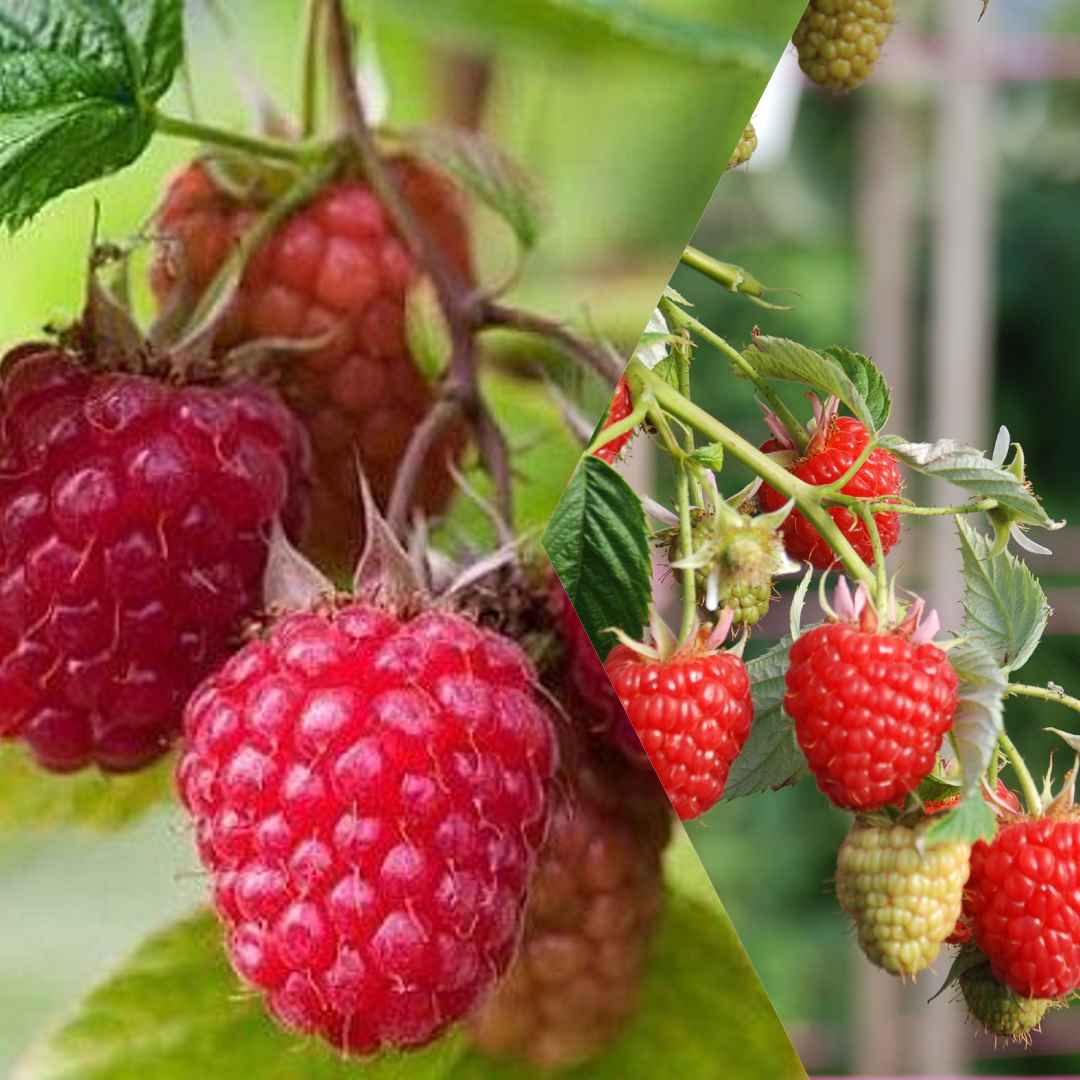Grow raspberries in your garden is a rewarding experience, offering sweet, juicy fruits that taste much better when picked fresh. Raspberries come in two types: summer-fruiting, which grow on last year’s canes and need support, and autumn-fruiting, which are shorter and produce fruit on new canes. By planting both, you can enjoy a harvest from June to October. While they require some care, like pruning and support for taller plants, the effort is worth it for the delicious homegrown berries. This guide will walk you through everything you need to know to successfully grow raspberries.
Types of Raspberries
When it comes to learning how to grow raspberries, the first step is to understand the two primary types available: summer-fruiting and autumn-fruiting raspberries. Each type has its unique characteristics and growing requirements.
Summer-Fruiting Raspberries
Summer-fruiting raspberries are a gardener’s favorite because they produce fruit on the previous year’s growth. Here are some key points to consider:
- Height and Staking: These varieties are typically tall and require staking for support as they can grow quite high.
- Harvest Time: Expect to enjoy a bountiful harvest during the summer months, usually from late June to early July.
Autumn-Fruiting Raspberries
On the other hand, autumn-fruiting raspberries have their own set of advantages:
- Growth Pattern: They produce fruit on the current season’s growth, making them generally easier to manage.
- Size and Vigour: These plants are usually shorter and less vigorous than their summer-fruiting counterparts, which can make them a great choice for smaller gardens.
Growing Conditions
To successfully grow raspberries, you need to provide the right environment. Raspberries thrive under specific conditions, which include:
- Soil Type: They prefer moist but free-draining, fertile soil. This ensures that the roots stay hydrated without becoming waterlogged.
- Sunlight: Raspberries are best grown in full sun to partial shade. While they can tolerate some shade, remember that the fruit will be sweeter when grown in sunny spots. So, when thinking about how to grow raspberries, consider their light needs carefully.
Planting Raspberries
Now that you’re familiar with the types of raspberries and their growing conditions, it’s time to discuss how to plant them properly.
When to Plant
You can plant raspberries in either autumn or spring, depending on your local climate. However, spring planting is often preferred for beginners.
Preparing the Soil
Before planting, soak the roots in water for a few hours to ensure they are hydrated.
Spacing and Depth
- Spacing: Space the canes 45 cm apart to allow for healthy growth, with 1.8 m between rows. This spacing helps with air circulation and reduces the risk of disease.
- Depth: Cover the roots with about 5 cm of soil, gently firming it around them.
Providing Support
For summer-fruiting varieties, you’ll need to provide support for the canes. Here’s how:
- Set up 2 m wooden posts at either end of your row and run wires between them.
- As the canes grow, tie them to these supports to keep them upright and healthy.
Caring for Raspberries
Once your raspberries are planted, proper care is crucial to ensure healthy growth and a bountiful harvest.
Fertilizing and Mulching
- In spring, use a general-purpose fertilizer to provide the necessary nutrients.
- Mulch around the base of the plants to keep the roots moist and suppress weeds, which compete for nutrients.
Watering
Ensure consistent watering, especially during dry spells. Raspberries are quite thirsty, and adequate moisture is essential for juicy, sweet fruits.
Pruning Raspberries
Pruning is a vital step in how to grow raspberries, affecting both yield and health. Here’s how to prune each type:
Pruning Summer-Fruiting Raspberries
- These raspberries fruit on one-year-old canes.
- After harvesting, cut back canes that have produced fruit to soil level, allowing new canes to develop for the next season.
- Tie in new canes to support them as they grow, ensuring they have enough space (about 15 cm apart) to thrive.
Pruning Autumn-Fruiting Raspberries
- These canes fruit on the current season’s growth.
- After the harvest, simply cut them down to the ground in winter. This method encourages new growth in spring, leading to a fruitful season ahead.
Harvesting Raspberries
The moment of truth—harvesting your delicious raspberries!
- Ripe fruits should easily come off the plant with a gentle tug, so be careful not to crush them during picking.
- Harvest regularly as they ripen to ensure you enjoy the best flavor and quality.
Pests and Diseases
As with any garden plants, raspberries can face their fair share of challenges. Here’s what to look out for:
Birds and Other Pests
- Birds: Blackbirds and other birds might want to share your harvest. You can net your raspberries, but be sure to check the netting regularly to prevent any animals from becoming trapped.
Nutrient Deficiencies
- In summer, watch for signs of raspberry nutrient deficiency. If you notice yellowing leaves, consider applying a high-nitrogen fertilizer and mulch annually with well-rotted manure or compost.
Shield Bugs
- While you might spot green shield bugs, don’t fret! These little guys are harmless and won’t damage your crop.
Storage Raspberries
Once you’ve harvested your raspberries, you’ll want to know how to store them properly:
- Fresh Use: Raspberries are best enjoyed the same day they’re picked.
- Refrigeration: If needed, store unwashed fruits in the fridge in a single layer to prevent crushing. They can last a few days this way, but avoid washing them until you’re ready to eat.
- Freezing: For longer storage, spread the raspberries out on a dish to open-freeze before transferring them to a box or bag. They’ll keep well for up to two months in the freezer.
Growing raspberries is a fantastic journey that rewards your effort with sweet, juicy fruits right from your garden. By understanding the different types of raspberries, providing the right growing conditions, planting and caring for them properly, and knowing how to harvest and store your fruits, you’re well on your way to enjoying a fruitful raspberry season. So, grab your gardening gloves and get ready to grow raspberries that will make your taste buds dance! Happy gardening!
FAQs
How do raspberries grow for beginners?
For beginners, raspberries grow best when planted in well-draining, fertile soil in a sunny location. Start by soaking the roots before planting, spacing the canes about 45 cm apart. Ensure they receive consistent watering and regular feeding in spring with a general fertilizer. Pruning is essential; summer-fruiting raspberries need care after harvesting, while autumn-fruiting can be cut back to the ground. Following these steps will help you successfully grow raspberries.
How long do raspberries take to grow?
Grow raspberries, and you can expect them to take about 1 to 2 years to produce a good harvest after planting. The first year is usually focused on establishing the plant, while the second year brings the first significant crop. Summer-fruiting raspberries typically bear fruit on one-year-old canes, whereas autumn-fruiting varieties can produce fruit in their very first year.
Where do raspberries grow best?
Raspberries thrive in moist, well-draining, fertile soil and prefer full sun to partial shade. They can tolerate some shade, but sweeter and more flavorful fruits are produced in sunnier spots. Choosing the right location with the right soil conditions is crucial for healthy raspberry plants.
Do raspberries grow better in pots or in the ground?
Grow raspberries in both pots and the ground, but they generally perform better when planted directly in the ground. In-ground plants have more space for root development, leading to a larger harvest. However, certain dwarf varieties can successfully grow in pots if space is limited. Just ensure the pot is large enough to accommodate the roots and provide good drainage.


